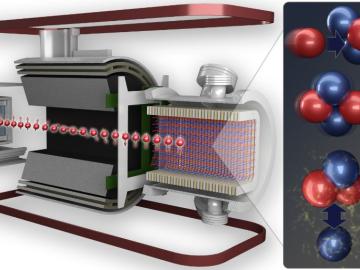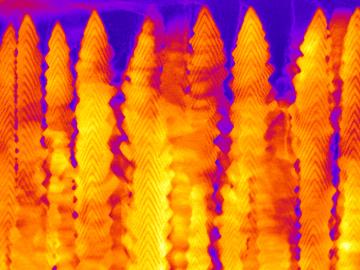
Filter News
Area of Research
- (-) Computer Science (2)
- (-) Energy Science (25)
- (-) Neutron Science (16)
- Biology and Environment (15)
- Energy Frontier Research Centers (1)
- Fusion and Fission (4)
- Isotopes (2)
- Materials (56)
- Materials for Computing (4)
- National Security (8)
- Nuclear Science and Technology (1)
- Quantum information Science (1)
- Sensors and Controls (1)
- Supercomputing (22)
News Topics
- (-) Chemical Sciences (10)
- (-) Grid (9)
- (-) Molten Salt (1)
- (-) Nanotechnology (10)
- (-) Physics (8)
- (-) Quantum Science (5)
- (-) Security (4)
- 3-D Printing/Advanced Manufacturing (31)
- Advanced Reactors (3)
- Artificial Intelligence (6)
- Big Data (2)
- Bioenergy (15)
- Biology (9)
- Biomedical (7)
- Biotechnology (3)
- Buildings (8)
- Clean Water (1)
- Composites (6)
- Computer Science (14)
- Coronavirus (9)
- Critical Materials (4)
- Cybersecurity (5)
- Energy Storage (27)
- Environment (14)
- Exascale Computing (2)
- Fossil Energy (1)
- Frontier (2)
- Fusion (2)
- High-Performance Computing (3)
- Isotopes (1)
- Machine Learning (4)
- Materials (21)
- Materials Science (24)
- Mercury (1)
- Microscopy (4)
- National Security (5)
- Neutron Science (40)
- Nuclear Energy (4)
- Partnerships (8)
- Polymers (5)
- Simulation (1)
- Space Exploration (1)
- Summit (5)
- Transportation (18)
Media Contacts

Through a one-of-a-kind experiment at ORNL, nuclear physicists have precisely measured the weak interaction between protons and neutrons. The result quantifies the weak force theory as predicted by the Standard Model of Particle Physics.

Scientists at Oak Ridge National Laboratory have demonstrated a direct relationship between climate warming and carbon loss in a peatland ecosystem.

Five researchers at the Department of Energy’s Oak Ridge National Laboratory have been named ORNL Corporate Fellows in recognition of significant career accomplishments and continued leadership in their scientific fields.

A team led by the Department of Energy’s Oak Ridge National Laboratory synthesized a tiny structure with high surface area and discovered how its unique architecture drives ions across interfaces to transport energy or information.
A team of scientists led by Oak Ridge National Laboratory found that while all regions of the country can expect an earlier start to the growing season as temperatures rise, the trend is likely to become more variable year-over-year in hotter regions.

Three researchers at Oak Ridge National Laboratory will lead or participate in collaborative research projects aimed at harnessing the power of quantum mechanics to advance a range of technologies including computing, fiber optics and network

IDEMIA Identity & Security USA has licensed an advanced optical array developed at Oak Ridge National Laboratory. The portable technology can be used to help identify individuals in challenging outdoor conditions.

An ORNL-led team's observation of certain crystalline ice phases challenges accepted theories about super-cooled water and non-crystalline ice. Their findings, reported in the journal Nature, will also lead to better understanding of ice and its various phases found on other planets, moons and elsewhere in space.

A team of scientists has for the first time measured the elusive weak interaction between protons and neutrons in the nucleus of an atom. They had chosen the simplest nucleus consisting of one neutron and one proton for the study.

Brixon, Inc., has exclusively licensed a multiparameter sensor technology from the Department of Energy’s Oak Ridge National Laboratory. The integrated platform uses various sensors that measure physical and environmental parameters and respond to standard security applications.


